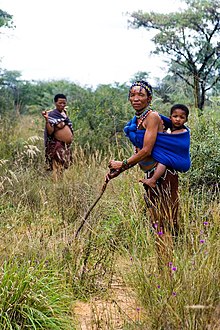 | |
| General Statistics | |
|---|---|
| Maternal mortality (per 100,000) | 195 (2017) |
| Women in parliament | 44.2% (2021) |
| Women over 25 with secondary education | 39.9% |
| Women in labour force | 58.5% (2017) |
| Gender Inequality Index | |
| Value | 0.445 (2021) |
| Rank | 111st out of 191 |
| Global Gender Gap Index | |
| Value | 0.807 (2022) |
| Rank | 8th out of 146 |
Women in Namibia face challenges in their health, gender based violence, and access to education. The government of Namibia is taking steps to provide women with equal rights to a degree that is largely unparalleled in Sub-Saharan Africa, including the promise of gender equality and increased parliament representation in the Namibian constitution. Women currently serve in nearly half of all seats in parliament and the first female Prime Minister was elected in 2015.
Health
HIV/AIDS is largely prevalent within Namibia. HIV-related deaths reached its peak in 2004, when 12,000 people died, but has since declined to around 2,900 deaths in 2021.
The socioeconomic status of women remains a significant indicator of HIV status. Of the poorest women in Namibia, the HIV prevalence rate is at 21.4%, compared to the richest households with an HIV prevalence rate of 3.7%.
Large strides have been made in the last decade to decrease the rate of maternal mortality in Namibia. In 2017, maternal mortality was at a rate of 195 deaths per 100,000 live births, down from 358 deaths per 100,000 live births in 2004. Life expectancy of women in Namibia has also improved. In 2020, the female life expectancy was 67 years, a large gap from 53 years in 2004.
Domestic violence
The nation's 1990 constitution guarantees women equal protection under law and prohibits gender discrimination. Although unprecedented for its time, there is much to be done to close the gender gap between men and women in Namibia.
Domestic violence remains a large concern in Namibia. On average 26.7% of Namibian women between ages 15–49 have experienced domestic and/or sexual violence at least once, with 52% of these women aged 15–19.
Namibia outlawed marital rape in 2000.
Legal rights and parliamentary representation
The nation's 1990 constitution guarantees women equal protection under law and prohibits gender discrimination.

Within the past decade, Namibia has seen increased pushes for the representation of women in parliament. In 2004, women constituted 29% of all parliament members, placing Namibia at seventeenth in the world for female representation in parliament. In 2014, the South West Africa People's Organisation introduced a policy committing to filling half of its seats in parliament with women, in addition to a "zebra" system in which a male prime minister would have a female deputy minister and vice versa. As of 2021, 44% of the Namibian parliament has seats filled by women.
In March 2015, Saara Kuugongelwa was appointed as Prime Minister of Namibia, making her the first woman to serve as Namibian Prime Minister.
References
- "Human Development Report 2021/2022" (PDF). HUMAN DEVELOPMENT REPORTS. Retrieved 19 December 2022.
- "Global Gender Gap Report 2022" (PDF). World Economic Forum. Retrieved 9 February 2023.
- "Namibia". UN Women. Retrieved 2019-02-24.
- ^ O'Riordan, Alexander; Service, from the South African Civil Society Information; AllAfrica.com, through; network, part of the Guardian development (2014-07-08). "Namibia's 'zebra' politics could make it stand out from the global herd | Alexander O'Riordan". The Guardian. ISSN 0261-3077. Retrieved 2019-02-24.
- ^ "Country Fact Sheet | UN Women Data Hub". data.unwomen.org. Retrieved 2023-02-06.
- "Namibia". www.unaids.org. Retrieved 2023-01-21.
- ^ Ekholuenetale, Michael; Onuoha, Herbert; Ekholuenetale, Charity Ehimwenma; Barrow, Amadou; Nzoputam, Chimezie Igwegbe (2021). "Socioeconomic Inequalities in Human Immunodeficiency Virus (HIV) Sero-Prevalence among Women in Namibia: Further Analysis of Population-Based Data". International Journal of Environmental Research and Public Health. 18 (17): 9397. doi:10.3390/ijerph18179397. ISSN 1660-4601. PMC 8431544. PMID 34501987.
- "Maternal mortality ratio (modeled estimate, per 100,000 live births) - Namibia | Data". data.worldbank.org. Retrieved 2023-02-06.
- "Life expectancy at birth, female (years) - Namibia | Data". data.worldbank.org. Retrieved 2023-02-06.
- "Women's Property Rights In Namibia: An Investigative Report to Determine The Potential for Litigation" (PDF). University of Wyoming Human Rights Clinic. January 2015.
- "| Human Development Reports". hdr.undp.org. Retrieved 2019-02-24.
- "Proportion of ever-partnered women and girls aged 15-49 years subjected to physical and/or sexual violence by a current or former intimate partner in the previous 12 months". www.who.int. Retrieved 2023-02-06.
- "Refworld | Namibia: Domestic violence, including state protection, services and recourse available to victims". Unhcr.org. Retrieved 2013-08-17.
- "Women's Property Rights In Namibia: An Investigative Report to Determine The Potential for Litigation" (PDF). University of Wyoming Human Rights Clinic. January 2015.
- "| Human Development Reports". hdr.undp.org. Retrieved 2019-02-24.
- Bauer, Gretchen (2004). "'The Hand That Stirs the Pot Can Also Run the Country': Electing Women to Parliament in Namibia". The Journal of Modern African Studies. 42 (4): 479–509. doi:10.1017/S0022278X04000370. ISSN 0022-278X. JSTOR 3876136. S2CID 154703040.
- "Saara Kuugongelwa-Amadhila". Council of Women World Leaders. Retrieved 2023-01-21.